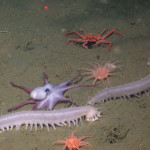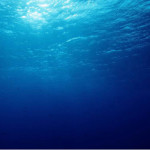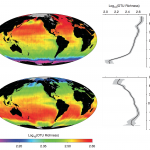
Figure reprinted from Cairns, 2007 in Bulletin of Marine Science
One of the central questions in marine biogeography asks “why are there more species of coral and fish in the Indo-Pacific Coral Triangle than anywhere else in the world?” By many accounts, this is the global epicenter of marine biodiversity. More than 1500 species of fish and 500 species of shallow hermatypic corals occur in the Coral Triangle compared to the other global epicenter of marine biodiversity, the Caribbean Sea, where you’ll find ‘only’ 900 species of fish and 50 species of corals (Carpenter and Springer 2005, Veron 1995).
Reasons for this exceptional richness include temperature, salinity, rapid speciation rates in the tropics, habitat heterogeneity, evolutionary isolation and subsequent radiation, stability over time, larval import, the species-area relationship (all reviewed in Rosen 1981), the mid-domain effect*, the depth of the aragonite saturation horizon (ASH), and perhaps the confluence of tectonic plates that brought disparate species together in one region.
Interestingly, azooxanthellate scleractinian corals from deep-water have similar patterns of species diversity. The most diverse region for deep corals overlaps the Coral Triangle, with 157 species, but the epicenter extends to New Caledonia, with 120 species. A second, smaller region of high diversity occurs in the Caribbean Sea. There are 81 azooxanthellate scleractinia from Cuba to the Lesser Antilles. A third epicenter, equal in richness to the Caribbean occurs in the northwestern Indian Ocean (Cairns, 2007).
The neat thing about the coincidence between deep-water and shallow water diversity contours is that 1) deep epicenters of biodiversity appear to underlie shallow epicenters of diversity, which is important for conservation and management and 2) several aforementioned hypotheses to explain diversity gradients are effectively ruled out (e.g. warm temperature, low salinity, evolutionary isolation). So, now we can start protecting deep habitats, too, and we can get a better handle on the reasons for these strong global gradients in marine biodiversity.
The paper was one of 19 manuscripts published in a special issue of Bulletin of Marine Science – Deep-Sea Coral Ecosystems: Biology and Geology, Proceedings from the Third International Symposium on Deep Sea Corals.
* Overlapping ranges of eastern and western species yields high richness in the middle
References:
Cairns, S.D. (2007). Deep-water corals: an overview with special reference to diversity and distribution of deep-water scleractinian corals. Bulletin of Marine Science, 81(3): 311-322.
Carpenter, KE and VG Springer. 2005. The center of the center of marine shore fish biodiversity: the Philippine Islands. Environmental Biology of Fishes 72(4):467-480. Link.
Rosen, BR. 1981. The tropical high diversity enigma- the coral’s eye view. pp 103-129 in PH Greenwood, ed. The evolving biosphere. Cambridge University Press, Cambridge.
Veron, JEN. 1995. Corals in space and time: the biogeography and evolution of the Scleractinia. USNW press, Sydney.






Well, if the deep diversity were driven by shallow diversity (and it seems plausible that organic enrichment from the surface might impact diversity in the deep), then the ultimate force behind the pattern could still be temperature, energy input, etc.
Good point. Yes, there is a productivity hypothesis I didn’t list there, but the highest diversity of scleractinia does not occur in productive high latitude waters. Diversity hotspots for scleractinia occur in the tropics. It may be different for gorgonacea.
I don’t believe water temperature would correlate with species richness. Temperatures in the deep sea are supposedly rather homogenous at low latitudes, between 2-4 degrees C, depending on the source water.